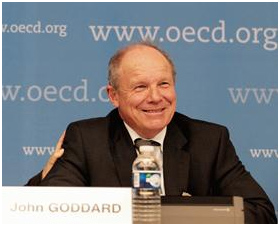Posted by Andy Pike, 19 March 2013
Two and half years on from the invitation to local councils and business leaders to form Local Enterprise Partnerships (LEPs) in England we have now reached a critical juncture in their development. The 39 sets of local actors across England have been busy building these new institutions and forging and nurturing partnerships since 2010. In the wake of Lord Heseltine’s review In Pursuit of Growth in late 2012 and its central call for more decentralisation of resources and responsibilities to LEPs, Government is shortly to announce its response in next week’s Budget.
Researchers in CURDS have undertaken the first national survey of all 39 LEPs as part of their involvement in the national Spatial Economics Research Centre (SERC) and the study sought to take stock of the current position and prospects for the LEPs. In early March 2012, CURDS hosted a seminar on ‘The State of the LEPs‘ to disseminate the preliminary findings and to engage in discussion about the issues with academics, analysts and policymakers from across England.
Several questions and issues critical to the current context were identified in the research and animated debate:
“What is the LEP?”
This fundamental question prompted some reflection on the specific nature and purpose of LEPs. For some in the CURDS research, the LEP constituted the Board while for others it was the locus of the local partnership for economic growth. Clarity on the aim, purpose and role of the LEPs remained a central issue on which LEPs were developing their own local views and they are were increasingly keen to better understand what Government has in mind for the longer term.
Are LEPs too small and fragmented really to add value and make a difference to local growth?
The size and scale of the LEPs and the fragmented character of the institutional arrangements was a very real concern to local and national economic development actors. Unflattering comparison was drawn with European and other regions whose more substantial and “heavy-weight” institutions and resources for regional and local economic development left the LEPs looking rather limited and under-powered in the competition for the investment, jobs and innovation to generate local growth. The CURDS research revealed a diverse picture of varied capacity and resources amongst the LEPs.
Establishing the staff and finances of the LEPs is complex. Staff contributions are direct, indirect and pro bono and in-kind from partner organisations. Finances comprise a range of funding streams – European, central and local – with some allocated and some won in competition. Direct staffing ranged from up to 40 to less than 1. Finances stretched from an estimated £40m to under £5m. In this kind of resource environment, it rang very true that for local economic growth the “LEPs were only as strong as their partners”.
How can central Government provide the advice and guidance on what the longer-term vision and plan is for LEPs in ways that don’t challenge the idea of ‘localism’ and undermine the autonomy local actors?
This issue is especially thorny. The CURDS research found that LEPs were crying out for a sense of where Government policy is heading and what further responsibilities and resources are coming over the horizon. Yet mixed and unclear messages were emerging from different Ministers and Departments. LEPs want a steer and direction – rather than prescription – on where Government would like to see institutional arrangements to facilitate local growth heading.
Are LEPs competitors and/or collaborators?
While the 39 LEPs were – in numerous cases – bottom-up entities, the CURDS research and discussion at the seminar focused on the issue of how the LEPs relate to each other within the broader network or system. There is evidence of chasing investments, firms and people for individual LEP areas. There are examples too of collaboration on issues of shared concern, whether with neighbouring LEPs or those further afield for example on MoD and the defence estate. Given the national centralisation of key policy areas important to local growth in inward investment and innovation, the CURDS research revealed an uneven set of relationships between specific LEPs and the key national institutions. In a competitive model, the more capable and better connected LEPs will forge ahead leaving others in their wake. In a collaborative model, the benefits of knowledge exchange and learning might be spread out across LEP-land. If rebalancing is still a serious government concern then some thought on how the overall system inter-relates and works would be timely.
How can LEPs maintain their streamlined organisations with growing responsibilities and resources to manage?
The fear articulated here was about “bureaucratisation” and losing the agile and focused ways in which LEPs are trying to do more with less. Balancing this concern was the need to be accountable for the decision-making and disbursement of public funds. Indeed, the CURDS research revealed many LEPs were uneasy and seeking advice on appropriate governance arrangements to address these concerns and assuage the anxieties of private sector board members. Engaging the private sector by giving them a real say was seen by LEPs as critical to sustaining their meaningful input. But how can it be done in ways that are accountable and transparent?
How much decentralisation and for whom?
In the wake of Lord Heseltine’s review, further decentralisation of responsibilities and resources are expected to be heading the way of the LEPs. Local actors expressed concerns about exactly how this would work. Would there be decentralisation in waves? Would an initial tier of more capable and strong LEPs with recognised economic opportunity and potential to contribute to local growth emerge at the front of the queue for further resources and responsibilities? Where this left the less capable and weaker LEPs was less clear.
Even given the history of flux in the governance arrangements for economic development in England and the alphabet soup of acronyms of the institutions of previous eras, it was felt that LEPs were likely be around for a while with little prospect of further change whatever the outcome of the General Election in 2015. Amongst the local actors there was little appetite for further institutional change and upheaval, the costs of which were still being felt by many in the wake of the dismantling of the regional tier. Fundamentally, local actors were trying to get on with the job of growing prosperity locally. “LEPs may come and go but the rationale for the local partnerships remain” as one participant put it.
As the LEPs await the announcements in next week’s Budget, rumination centred upon whether or not a collective voice for the “LEP family” could or should emerge. Two and half years in LEPs have been largely reactive to the changing landscape of economic development governance policy emanating from the centre. In the next two and half years, LEPs might decide that their shared concerns and interests would be better articulated in a collective and proactive way. This is especially the case if the current government’s predilection for the ‘deal-making’ of “asks” and “offers” continues to shape centre-local relations in England.

Participants from the seminar’s closing panel are pictured (left to right): David Marlow (Third Life Economics), Gillian Roll (North East LEP), Linda Edworthy (Tees Valley LEP), Paul Hackett (The Smith Institute), Lorna Gibbons (The LEP Network) and Andy Pike (CURDS, Newcastle University)
- You can also view the slides from the seminar.



